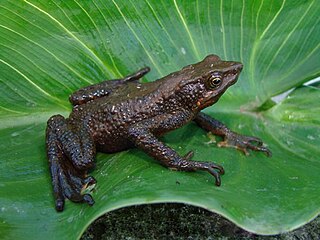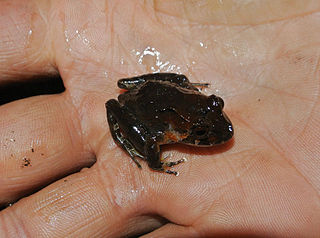
Atelopus laetissimus, the San Lorenzo Stubfoot Toad, is a species of toad in the family Bufonidae. It is endemic to Colombia and only known from the area of its type locality in the northwestern part of the Sierra Nevada de Santa Marta, in the Magdalena Department.
Atelopus monohernandezii is a species of toads in the family Bufonidae. It is endemic to Colombia and only known from the vicinity of its type locality on the western slope of the Cordillera Oriental, Santander Department. It has not been observed after 1982 and the remaining population is believed to be very small, if surviving at all.

Atelopus nahumae is a species of toad in the family Bufonidae. It is endemic to Colombia and only known from humid montane forest of Sierra Nevada de Santa Marta in the Magdalena, La Guajira, and Cesar Departments.
Centrolene acanthidiocephalum, commonly known as the Santander giant glass frog, is a species of frog in the family Centrolenidae. Its current placement within the subfamily Centroleninae is uncertain. It is endemic to Colombia where it is only known from the region of the type locality on the western slope of the Cordillera Oriental in the Santander Department, at the elevations of 1,750–2,100 m (5,740–6,890 ft) asl.
Centrolene huilensis is a species of frog in the family Centrolenidae. It is endemic to Colombia and only known from the region of its type locality near Isnos, on the Cordillera Central in the Huila Department.
Cochranella litoralis is a species of frog in the family Centrolenidae. It is known from the Pacific lowlands of southwestern Colombia and northern Ecuador. The specific name litoralis refers to the proximity of the type locality to the sea.

Ikakogi tayrona, or the Magdalena giant glass frog, is a species of frog in the family Centrolenidae. It is endemic to the Sierra Nevada de Santa Marta, Magdalena Department, Colombia. It is the only glass frog that is known to show maternal care.
Nymphargus armatus is a species of frog in the family Centrolenidae. It is endemic to Colombia and only known from the immediate vicinity of its type locality in El Cairo municipality, Valle del Cauca Department. In much of the literature it is known as Cochranella armata as it was moved to its present genus only in 2007.
Nymphargus garciae is a species of frog in the family Centrolenidae, formerly placed in Cochranella. It is endemic to the eastern slopes of the Cordillera Central, Colombia. Its natural habitat is vegetation alongside streams in sub-Andean and Andean forests. It requires gallery forest for reproduction, and is therefore very sensitive to disturbance of this kind of habitat. It is threatened by habitat loss.
Nymphargus nephelophila is a species of frogs in the family Centrolenidae, formerly placed in Cochranella. It is endemic to the Caquetá Department, Colombia, where it is known from the eastern versant of the Cordillera Oriental near Florencia. Its natural habitat is vegetation near streams in cloud forest, including secondary forest. Habitat loss is a threat to this species, but it is too little known to assess its conservation status.
Nyctimystes fluviatilis, also known as the Indonesian big-eyed tree frog, is a species of frog in the subfamily Pelodryadinae of the family Hylidae. It is endemic to New Guinea and is known from Idenburg River and Wapoga River in Papua province, Indonesia, and from the Torricelli Mountains in the East Sepik Province and Kavorabip in the Western Province, both in the western Papua New Guinea.
Pristimantis piceus is a species of frog in the family Strabomantidae. It is endemic to Colombia and occurs in the Cordillera Central between the Antioquia Department in the north and the Cauca Department in the south. Many specimens are black in color, and the specific name piceus is Latin meaning "pitch-black".
Pristimantis polemistes is a species of frogs in the family Strabomantidae. It is endemic to Colombia and only known from the vicinity of its type locality in Urrao, Antioquia Department, on the western flank of the Cordillera Occidental. The specific name polemistes is Greek for "warrior" and refers to the insurgents that operated in the area of the type locality.
Serranobatrachus ruthveni is a species of frog in the family Craugastoridae. It is endemic to the north-western slope of the Sierra Nevada de Santa Marta in the Magdalena Department, northern Colombia. The specific name ruthveni honors Alexander Grant Ruthven, an American herpetologist. Common name Ruthven's robber frog has been coined for this species.

Pristimantis scopaeus is a species of frog in the family Strabomantidae. It is endemic to Colombia and occurs in the Cordillera Central in the Tolima and Quindío Departments. Pristimantis scopaeus is a dwarf species: adult males in the type series were first mistaken for juveniles of Pristimantis simoteriscus, which itself already is a small species. The specific name scopaeus is Latinization of the Greek skopaios, meaning "dwarf".

Tachiramantis tayrona is a species of frog in the family Strabomantidae. It is endemic to the north-western Sierra Nevada de Santa Marta, Colombia. The specific name tayrona refers to the pre-Columbian Tairona culture. Lynch and Ruíz-Carranza suggest that this species might have been a model for the gold frogs unearthed from archaeological sites in the area.
Pristimantis veletis is a species of frog in the family Strabomantidae. It is endemic to Colombia and is only known from the vicinity of its type locality in Samaná and Pensilvania municipalities in the Caldas Department, on the eastern slope of the Cordillera Central. The specific name veletis is Latin from "skirmisher". It alludes to the resemblance of the color pattern of this frog to the camouflage clothing of the guerillas that were present in the area of the type locality, as well as to the chin pattern that loosely resembles the chevrons in some military uniforms.

Savage's salamander, also known as Savage's mushroomtongue salamander, is a species of salamander in the family Plethodontidae. It is endemic to the Sierra Nevada de Santa Marta in northern Colombia. The record from Venezuela represents another species, likely Bolitoglossa guaramacalensis. The species is named after Jay M. Savage, an American herpetologist.
Papurana grisea is a species of true frog. It is known with certainty only from its type locality in the Went Mountains, in the Indonesian province of Papua, New Guinea. Similar frogs are widespread in New Guinea, usually above 1,200 m (3,900 ft) above sea level, as well as on the Seram Island, but their identity is uncertain; they possibly represent another, undescribed species. Common names Went Mountains frog and Montaen swamp frog have been coined for it.

Centrolene savagei is a species of frog in the family Centrolenidae that is endemic to the Andes of western Colombia, specifically the Cordillera Occidental and Cordillera Central. Its common name is Savage's Cochran frog.








